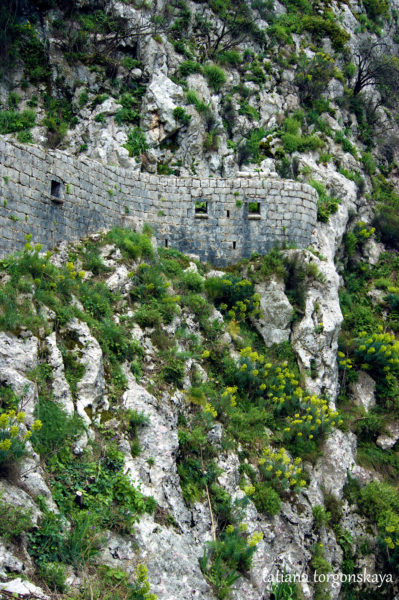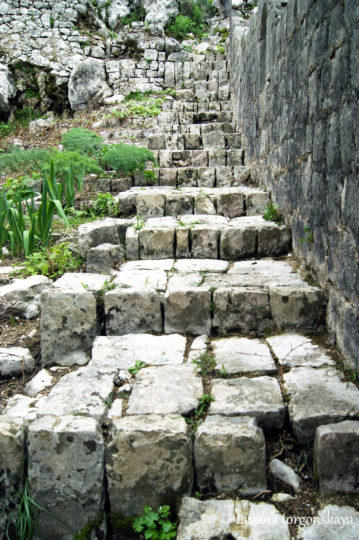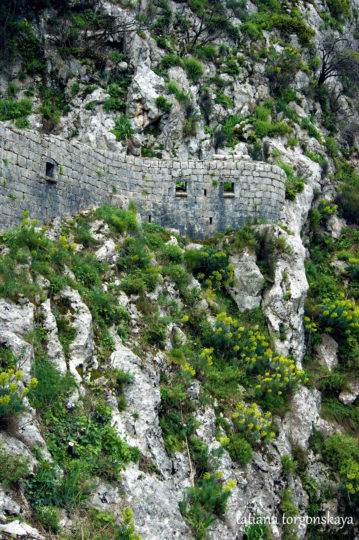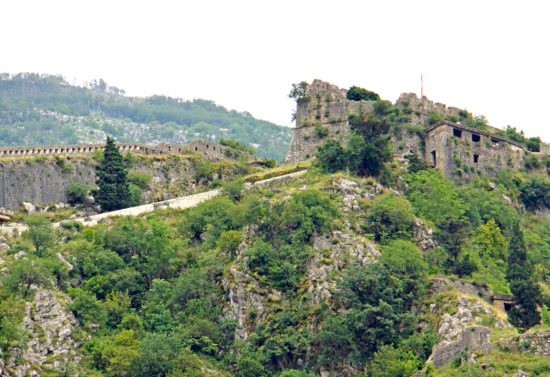
The fortress of St. John is located at an altitude of 280 meters above sea level. From the observation deck of the fortress, you can see not only Kotor but also the entire Bay of Kotor.
The fortress of St. Ioanna defends the city from the eastern side , a zigzag wall with a thickness of up to 20 meters goes all the way to the fort. More than 38 cannons were installed along the entire length of the wall, which made it possible to defend the city for a long time. An example of an unsuccessful attempt to capture the Ottomans to take the city with the help of 300 ships.
The ascent to the fortress consists of 1400 narrow stone steps, we advise you to plan the ascent to the fortress in the morning, as it will be more difficult to climb in the heat.
The Kotor Fortress surrounding the Old Town of Kotor is an impressive example of medieval fortification.
It includes the following elements:
- The main fortress wall, which is a massive structure up to 16 meters wide, 20 meters high and 4.5 kilometers long. It wraps around the Old Town of Kotor and rises to the top of the hill.
- A stone staircase leading to the bastion of Sv. Roko and the Church of Our Lady of Health (Gospa od zdravlja).
- The highest point of Kotor is the fortification of St. Ivan (bastione di San Giovanni or “Illyrian Fort”) on top of the mountain.
The highest point of Kotor is the fortification of St. Ivan (bastione di San Giovanni or “Illyrian Fort”) on the top of the mountain. The fortification wall was built around the Old Town of Kotor over the centuries from the ninth to the nineteenth century. This fortified ring served to protect the town from attacks from both sea and land. The main part of the wall, which surrounds the town, was built in the XIII-XIV centuries, when Kotor (Cataro) was an outpost of the Venetian Republic in southern Dalmatia.
This period was the most dramatic in the city’s history, as during most of the Venetian rule Kotor and Boka Kotorska were a battlefield with the Ottoman Empire, whose possessions were only a few hours away from the city walls.
Fortress Entrance
Since that time, from 1657, a large part of the fortress became inaccessible to the public, a situation that continues until today. The reason behind this lies in an amazing story that seems almost unbelievable, but is marvelous in its beauty.
Due to unclear circumstances, neither locals nor tourists have been able to fully explore the entire fortress for almost five hundred years. This is a fact that gives a special mystery and attraction to this place.
The most interesting thing is that historians claim that the construction of the fortress began long before this time, back in the ancient era, when the Illyrians were the first to erect the walls of the fortress in the mentioned places. High on the hill, the “Illyrian Fort” (now known as St. Ivan’s Fortress) has been preserved, and its construction is attributed to them. Later, in the 3rd century BC, the Romans who came to the region hastily reinforced the existing bastions.
Then each dominant state – Byzantines, Arabs, Venetians, Turks and others – rebuilt or added to the fortress in their own way. Because of this, traces of each period in the history of Kotor can be seen inside the fortress. Trade was especially active during the Venetian domination of the Boko Kotor Bay towns under the flag of St. Mark, and it was due to the influence of Venice that the basic appearance of the town that we see today was formed.
Despite all the historical changes and influences, much of the fortress remains inaccessible to the public. This mysterious situation gives a special charm to the history of Kotor and its fortress, which attracts tourists with its uniqueness and mystical charm.
History
During the Kandyan War between the Ottoman Empire and the Republic of Venice, in 1657, Kotor was besieged by Turkish forces, which numbered about 5,000 soldiers. The Turks sought to capture Kotor because its control allowed them to control the entire Boka Kotor Bay. In response, the people of Kotor closed themselves inside the fortress, locking the only door leading outside (which, by the way, was made of stone). The problem was that as a sign of patriotism and determination, none of them were going to surrender, so they threw the key into the sea.
Despite several attempts by the Turks, they were unable to capture the bastion either by storm or siege, and after two months they retreated. The townspeople, however, remained in a completely isolated position.
Fortunately, there was a water source inside the fortress, known as the “Well of Carampana“, and provisions were delivered to the fortress by means of a catapult used by the Venetians who had returned to the bay. This continued for several years until the city was hit by an earthquake that destroyed half of the buildings. However, the walls of the fortress proved to be strong and resilient, with only a crack in them, through which people managed to escape.
And immediately after that, the crack closed at the next push. Thus, half of the bastion was not only impregnable, but also closed to any attempts to penetrate inside. Despite endless attempts, no one managed to get inside.
In honor of this victory, the citizens built a new entrance to Kotor, the River (north) gate of the city.
However, the Turks were not the only misfortune awaiting the city, the fortress and its inhabitants. They also suffered from natural disasters, including epidemics and earthquakes. At various times, the plague visited the city in 1422, 1427, 1457, 1467 and 1572. In addition, Kotor was subjected to earthquakes in 1537 and 1563, and the Great Earthquake on April 6, 1667 almost completely destroyed the city, including the bell tower of the Cathedral of Saint Tryphon.
Over the centuries, Kotor has been the scene of fierce battles and has changed hands. It was occupied by Austro-Hungarian, French, Italian and German troops. Despite all this, Kotor survived, liberated in November 1944 and became part of the rebuilt Yugoslavia. Today, the date of liberation – November 21, 1944 – is carved in stone above the main gate of the Old Town of Kotor.
The fortress walls are of particular interest nowadays, as you can climb them and walk around the perimeter of Kotor at roof level. There are passages in several places, and to find them you have to walk along the wall and look for stairs.
.



